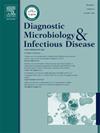1例免疫功能正常患者因单核细胞增生李斯特菌引起的主动脉瘤自发性破裂及文献复习。
IF 2.1
4区 医学
Q3 INFECTIOUS DISEASES
Diagnostic microbiology and infectious disease
Pub Date : 2024-12-29
DOI:10.1016/j.diagmicrobio.2024.116673
引用次数: 0
摘要
感染性动脉瘤代表本文章由计算机程序翻译,如有差异,请以英文原文为准。
Spontaneous rupture of aortic aneurysm due to Listeria monocytogenes in an immunocompetent patient and review of the literature
Infectious aneurysms represent <5 % of cases [1] with a crucial and challenging diagnosis. Staphylococcus, Streptococcus, Enterobacteria are mostly involved but unusual pathogens like Listeria monocytogenes can be responsible. Collecting data of these rare situations allows to improve diagnosis. We report a case of L. monocytogenes aortic aneurysm, at a departmental hospital, in a 77-year-old immunocompetent patient without endovascular material, with an antecedent of colorectal carcinoma in remission and alcoholism, and compared it with literature data. Blood cultures were negative but culture of aortic tissues was positive. Only 19 similarly cases were identified since 1965. Infectious aneurysm represents a serious condition with a difficult diagnosis needing multiple approaches. When an infection is suspected, collection of blood culture and tissue of the aortic wall are needed as well as biomolecular and serological tools for exigent pathogens.
求助全文
通过发布文献求助,成功后即可免费获取论文全文。
去求助
来源期刊
CiteScore
5.30
自引率
3.40%
发文量
149
审稿时长
56 days
期刊介绍:
Diagnostic Microbiology and Infectious Disease keeps you informed of the latest developments in clinical microbiology and the diagnosis and treatment of infectious diseases. Packed with rigorously peer-reviewed articles and studies in bacteriology, immunology, immunoserology, infectious diseases, mycology, parasitology, and virology, the journal examines new procedures, unusual cases, controversial issues, and important new literature. Diagnostic Microbiology and Infectious Disease distinguished independent editorial board, consisting of experts from many medical specialties, ensures you extensive and authoritative coverage.

 求助内容:
求助内容: 应助结果提醒方式:
应助结果提醒方式:


